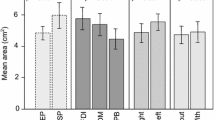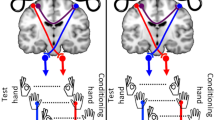Abstract
The transcallosal connecting fibres linking corresponding projection areas of the same muscles of the right and left primary motor cortex may play an important role in control of unilateral movements. It appears that they have mainly inhibitory effects. This was further evaluated by transcranial magnetic stimulation using two focal coils placed on the optimal positions, i.e. the positions with the lowest thresholds at the motor representation areas of the first dorsal interosseous muscle of the left and right sides. A conditioning stimulus was given to one hemisphere 10 ms prior to the test stimulus at the opposite hemisphere. The inhibition was evaluated as relative amplitude reduction. Eleven normal right-handed subjects and 11 normal left-handed subjects participated in this study. Handedness was evaluated by the Oldfield inventory. It was found that in right-handers the inhibition after stimulation of the “dominant” left hemisphere was more marked than after stimulation of the “non-dominant” right hemisphere. In contrast, the group of left-handed subjects showed inhomogeneous findings with either right- or left-side predominant inhibition. It is concluded that not handedness but hemispheric dominance contributes to the laterality of inhibition. The results point to a superior role of the language-dominant hemisphere in governing inter-hemispheric control of motor cortical connections, supporting the view that the “language-dominant” hemisphere is also “motor dominant”.
Similar content being viewed by others
References
Abercrombie MLJ, Lindon RL, Tyson MC (1964) Associated movements in normal and physically handicapped children. Dev Med Child Neurol 6:573–80
Annett M (1985) Left, right, hand and brain: the right shift theory. Erlbaum Associates, London
Asanuma H, Okamoto K (1959) Unitary study on evoked activity of callosal neurones and its effect on pyramidal tract cell activity on cats. Jpn J Physiol 9:473–483
Asanuma H, Okuda O (1962) Effects of transcallosal volleys on pyramidal tract cell activity of cat. J Neurophysiol 25:198–208
Benson DF, Zaidel E (1985) The dual brain. Guilford, New York
Branch C, Milner B, Rasmussen T (1964) Intracarotid sodium amytal for the lateralization of cerebral dominance. J Neurosurg 21:399–405
Britton TC, Meyer B-U, Benecke R (1991) Central motor pathways in patients with mirror movements. J Neurol Neurosurg Psychiatr 54:505–510
Cantello R, Gianelli M, Bettucci D, Tribolo A, Mutani R (1992a) Threshold to magnetic stimulation of hand motor cortex: effects of handedness (abstract). Electroencephalogr Clin Neurophysiol 87:40
Cantello R, Gianelli M, Bettucci D, Civardi C, Tribolo A, Mutani R (1992b) Modulation of magnetic motor evoked potentials in right- and left-handers (abstract). Electroencephalogr Clin Neurophysiol 87:17
Chi JG, Dooling EC, Gilles FH (1977) Left-right asymmetries of the temporal speech areas of the human fetus. Arch Neurol 34:346–348
Cohen LG, Meer J, Tarkka I, Bierner S, Leidermann PB, Dabinsky RM, Sanes JN, Jabbori B, Breues B, Hallett M (1991) Congenital mirror movements. Abnormal organization of motor pathways in two patients. Brain 114:381–403
Connolly K, Stratton P (1968) Developmental changes in associated movements. Dev Med Child Neurol 10:49–56
Conrad K (1949) Über aphasische Sprachstörungen hirnverletzter Linkshänder. Nervenarzt 20:148
Cook ND (1986) The brain code: mechanisms of information transfer and the role of the corpus callosum. Methuen, London
Crandall PW (1985) Clinical phenomenology following hemispherectomy and the syndromes of hemispheric disconnection. In: Benson DF, Zaidel E (eds) The dual brain. Guilford, New York
Cusick CG, Kaas J (1986) Interhemispheric connections of cortical sensory and motor representations in primates. In: Lepore F, Ptito M, Jasper HH (eds) Two hemispheres — one brain: functions of the corpus callosum. Liss, New York, pp 83–102
Danek A, Heye B, Schroedter R (1992) Cortically evoked motor responses in patients with Xp22. 3-linked Kallmann's syndrome and in female gene carriers. Ann Neurol 31:299–304
Dennis M (1976) Impaired sensory and motor differentiation with callosal agenesis: a lack of callosal inhibition during ontogeny? Neuropsychologia 14:455–69
Farmer SF, Ingram DA, Stephens JA (1990) Mirror movements studied in a patient with Klippel-Feil syndrome. J Physiol (Lond) 428:467–484
Ferbert A, Priori A, Rothwell JC, Day BL, Colebatch JG, Marsden CD (1992) Interhemispheric inhibition of the human motor cortex. J Physiol (Lond) 453:525–546
Fog E, Fog M (1963) Cerebral inhibition examined by associated movements. In: MacKeith R, Bax M (eds) Minimal cerebral dysfunction. Little club clinics in developmental medicine, No. 10. Heinemann, London, pp 52–7
Gould HJ, Cusick CG, Pous TP, Kaas JH (1986) The relationship of corpus callosum connection to electrical stimulation maps of motor, supplementary motor, and the frontal eye fields in owl monkeys. J Comp Neurol 247:297–325
Green JB (1967) An electromyographic study of mirror movements. Neurology (Minneapolis) 17:91–44
Gunderson CH, Solitare GB (1968) Mirror movements in patients with the Klippel-Feil syndrome. Arch neurol (1968;18:675–9
Hecaen H, De Agostini M, Monzon-Montes A (1981) Cerebral organization in left-handers. Brain Lang 12:261–284
Hess CW, Mills KR, Murray NMF (1986a) Magnetic stimulation of the human brain. Facilitation of motor responses by voluntary contraction of ipsilateral and contralateral muscles with additional observations on MRT. Neurosci Lett 71:235–240
Hess CW, Mills KR, Murray NMF (1986b) Magnetic stimulation of the human brain. The effects of voluntary muscle activity (abstract). J Physiol (Lond) 378:37
Hömberg V, Stephan KM, Netz J (1991) Transcranial stimulation of motor cortex in upper motor neuron syndrome: its relation to the motor deficit. Electroencephalogr Clin Neurophysiol 81:377–388
Kristeva R, Cheyne D, Deecke L (1991) Neuromagnetic fields accompanying unilateral and bilateral voluntary movements: topography and analysis of cortical sources. Electroencephalogr Clin Neurophysiol 81:284–298
Liepmann H, Mass O (1907) Ein Fall von linksseitiger Agraphie und Apraxie bei rechtsseitiger Lähmung. Monatsschr Psychiatr Neurol 10:214–22
Macdonell RA, Shapiro BE, Chiappa KH, Helmers SL, Cros P, Day BJ, Shahani BT (1991) Hemispheric threshold differences for motor evoked potentials produced by magnetic coil stimulation. Neurology 41:1441–1444
Matsunami K, Hamada I (1984) Effects of stimulation of corpus callosum on precentral neuron activity in the awake monkey. J Neurophysiol 52:676–691
Moskovitch M (1976) On the representation of language in the right hemisphere of right handed people. Brain Lang 3:47–71
Nass R (1985) Mirror movement asymmetries in congenital hemiparesis: the inhibition hypothesis revisited. Neurology 35:1059–1062
Oldfield RC (1971) The assessment and analysis of handedness: the Edinburgh Inventory. Neuropsychologia 9:97–114
Penfield W, Roberts L (1959) Speech and brain-mechanisms. Princeton University Press, Princeton, NJ
Purpura DP, Girado M (1959) Synaptic mechanisms involved in transcallosal activation of cortico-spinal neurones. Arch Ital Biol 47:111–139
Regard M, Cook ND, Wieser HG, Landis T (1994) The dynamics of cerebral dominance during unilateral limbic seizures. Brain 117:91–104
Roland PE, Skinhöj E, Lassen NA, Larsen N (1980) Different cortical areas in man in the organization of voluntary movements in extrapersonal space. J Neurophysiol 43:137–150
Rossini PM, Zarola F, Stalberg E, Caramina M (1988) Pre-movement facilitation of motor evoked potentials in man during transcranial stimulation of the central motor pathways. Brain Res 458:20–30
Rothwell JC, Thompson PD, Day BL (1987) Motor cortex stimulation in intact man. I. General characteristics of EMG-responses in different muscles. Brain 110:1173–1190
Russell WR, Espir MLE (1961) Traumatic aphasia — a study of aphasia in war wounds of the brain. Oxford university Press, London
Shibasaki H, Nagae K (1984) Mirror movement: application of movement-related cortical potentials. Ann Neurol 15:299–302
Steinmetz H, Volkmann J, Jäncke L, Freund H-J (1991) Anatomical left-right asymmetry of language-related temporal cortex is different in left- and right-handers. Ann Neurol 29:315–319
Stern JA, Gold S, Hoine H, Barocas VS (1976) Towards a more refined analysis of the “overflow” or “associated movement” phenomenon. In: Siva Sankar DV (ed) Mental health in children, vol 2. PJD, Westbury, NY, pp 113–28
Wada J, Clarke R, Hamm A (1975) Cerebral hemispheric asymmetry in humans. Cortical speech zones in 100 adults and 100 infant brains. Arch Neurol 32:239–246
Weiller C, Chollet F, Friston KJ, Wise RJS, Frackowiak RSJ (1992) Functional reorganization of the brain in recovery from striatocapsular infarction in man. Ann Neurol 31:463–472
Weiller C, Ramsay SC, Wise RJS, Friston KJ, Frackowiak RSJ (1993) Individual patterns of functional reorganization in the human cerebral cortex after capsular infarction. Ann Neurol 33:181–189
Woods BT, Teuber H-L (1978) Mirror movements after childhood hemiparesis. Neurology 28:1152–8
Zaidel E (1985) Language in the right hemisphere. In: Benson DF, Zaidel E (eds) The dual brain. Guilford Press, New York, pp 205–231
Züilch RJ, Müller N (1969) Associated movements in man. In: PJ Vinken and GW Bruyn (eds) Handbook of clinical neurology. Vol.1, Amsterdam, North-Holland, pp 404–426
Author information
Authors and Affiliations
Rights and permissions
About this article
Cite this article
Netz, J., Ziemann, U. & Hömberg, V. Hemispheric asymmetry of transcallosalinhibition in man. Exp Brain Res 104, 527–533 (1995). https://doi.org/10.1007/BF00231987
Received:
Accepted:
Issue Date:
DOI: https://doi.org/10.1007/BF00231987




